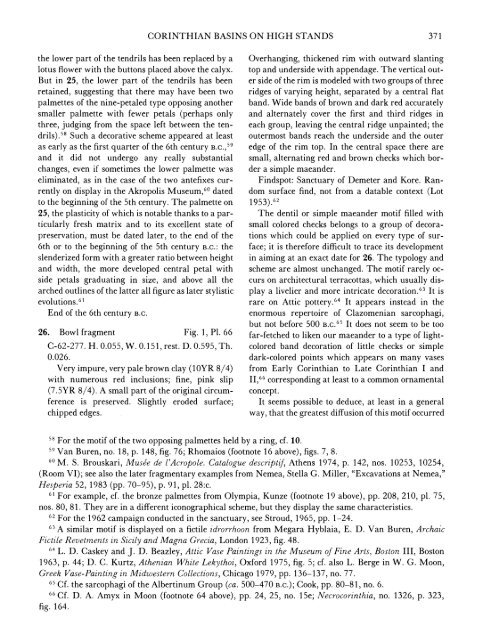f - The American School of Classical Studies at Athens
f - The American School of Classical Studies at Athens
f - The American School of Classical Studies at Athens
Create successful ePaper yourself
Turn your PDF publications into a flip-book with our unique Google optimized e-Paper software.
the lower part <strong>of</strong> the tendrils has been replaced by a<br />
lotus flower with the buttons placed above the calyx.<br />
But in 25, the lower part <strong>of</strong> the tendrils has been<br />
retained, suggesting th<strong>at</strong> there may have been two<br />
palmettes <strong>of</strong> the nine-petaled type opposing another<br />
smaller palmette with fewer petals (perhaps only<br />
three, judging from the space left between the ten-<br />
drils).58 Such a decor<strong>at</strong>ive scheme appeared <strong>at</strong> least<br />
as early as the first quarter <strong>of</strong> the 6th century B.C.,"<br />
and it did not undergo any really substantial<br />
changes, even if sometimes the lower palmette was<br />
elimin<strong>at</strong>ed, as in the case <strong>of</strong> the two antefixes cur-<br />
rently on display in the Akropolis Museum,60 d<strong>at</strong>ed<br />
to the beginning <strong>of</strong> the 5th century. <strong>The</strong> palmette on<br />
25, the plasticity <strong>of</strong> which is notable thanks to a par-<br />
ticularly fresh m<strong>at</strong>rix and to its excellent st<strong>at</strong>e <strong>of</strong><br />
preserv<strong>at</strong>ion, must be d<strong>at</strong>ed l<strong>at</strong>er, to the end <strong>of</strong> the<br />
6th or to the beginning <strong>of</strong> the 5th century B.C.: the<br />
slenderized form with a gre<strong>at</strong>er r<strong>at</strong>io between height<br />
and width, the more developed central petal with<br />
side petals gradu<strong>at</strong>ing in size, and above all the<br />
arched outlines <strong>of</strong> the l<strong>at</strong>ter all figure as l<strong>at</strong>er stylistic<br />
evolutions.61<br />
End <strong>of</strong> the 6th century B.C.<br />
26. Bowl fragment Fig. 1, P1. 66<br />
C-62-277. H. 0.055, W. 0.151, rest. D. 0.595, Th.<br />
0.026.<br />
Very impure, very pale brown clay (1OYR 8/4)<br />
with numerous red inclusions; fine, pink slip<br />
(7.5YR 8/4). A small part <strong>of</strong> the original circum-<br />
ference is preserved. Slightly eroded surface;<br />
chipped edges.<br />
CORINTHIAN BASINS ON HIGH STANDS 371<br />
Overhanging, thickened rim with outward slanting<br />
top and underside with appendage. <strong>The</strong> vertical outer<br />
side <strong>of</strong> the rim is modeled with two groups <strong>of</strong> three<br />
ridges <strong>of</strong> varying height, separ<strong>at</strong>ed by a central fl<strong>at</strong><br />
band. Wide bands <strong>of</strong> brown and dark red accur<strong>at</strong>ely<br />
and altern<strong>at</strong>ely cover the first and third ridges in<br />
each group, leaving the central ridge unpainted; the<br />
outermost bands reach the underside and the outer<br />
edge <strong>of</strong> the rim top. In the central space there are<br />
small, altern<strong>at</strong>ing red and brown checks which border<br />
a simple maeander.<br />
Findspot: Sanctuary <strong>of</strong> Demeter and Kore. Random<br />
surface find, not from a d<strong>at</strong>able context (Lot<br />
1953) 62<br />
<strong>The</strong> dentil or simple maeander motif filled with<br />
small colored checks belongs to a group <strong>of</strong> decor<strong>at</strong>ions<br />
which could be applied on every type <strong>of</strong> surface;<br />
it is therefore difficult to trace its development<br />
in aiming <strong>at</strong> an exact d<strong>at</strong>e for 26. <strong>The</strong> typology and<br />
scheme are almost unchanged. <strong>The</strong> motif rarely occurs<br />
on architectural terracottas, which usually display<br />
a livelier and more intric<strong>at</strong>e decor<strong>at</strong>ion.63 It is<br />
rare on Attic pottery.64 It appears instead in the<br />
enormous repertoire <strong>of</strong> Clazomenian sarcophagi,<br />
but not before 500 B.c.65 It does not seem to be too<br />
far-fetched to liken our maeander to a type <strong>of</strong> lightcolored<br />
band decor<strong>at</strong>ion <strong>of</strong> little checks or simple<br />
dark-colored points which appears on many vases<br />
from Early Corinthian to L<strong>at</strong>e Corinthian I and<br />
I1,66 corresponding <strong>at</strong> least to a common ornamental<br />
concept.<br />
It seems possible to deduce, <strong>at</strong> least in a general<br />
way, th<strong>at</strong> the gre<strong>at</strong>est diffusion <strong>of</strong> this motif occurred<br />
58 For the motif <strong>of</strong> the two opposing palmettes held by a ring, cf. 10.<br />
59 Van Buren, no. 18, p. 148, fig. 76; Rhomaios (footnote 16 above), figs. 7, 8.<br />
60 M. S. Brouskari, Musee de l'Acropole. C<strong>at</strong>alogue descriptif, <strong>Athens</strong> 1974, p. 142, nos. 10253, 10254,<br />
(Room VI); see also the l<strong>at</strong>er fragmentary examples from Nemea, Stella G. Miller, "Excav<strong>at</strong>ions <strong>at</strong> Nemea,"<br />
Hesperia 52, 1983 (pp. 70-95), p. 91, pl. 28:c.<br />
61 For example, cf. the bronze palmettes from Olympia, Kunze (footnote 19 above), pp. 208, 210, pl. 75,<br />
nos. 80, 81. <strong>The</strong>y are in a different iconographical scheme, but they display the same characteristics.<br />
62 For the 1962 campaign conducted in the sanctuary, see Stroud, 1965, pp. 1-24.<br />
63 A similar motif is displayed on a fictile idrorrhoon from Megara Hyblaia, E. D. Van Buren, Archaic<br />
Fictile Revetments in Sicily and Magna Grecia, London 1923, fig. 48.<br />
64 L. D. Caskey and J. D. Beazley, Attic Vase Paintings in the Museum <strong>of</strong> Fine Arts, Boston III, Boston<br />
1963, p. 44; D. C. Kurtz, Athenian White Lekythoi, Oxford 1975, fig. 5; cf. also L. Berge in W. G. Moon,<br />
Greek Vase-Painting in Midwestern Collections, Chicago 1979, pp. 136-137, no. 77.<br />
65 Cf. the sarcophagi <strong>of</strong> the Albertinum Group (ca. 500-470 B.C.); Cook, pp. 80-81, no. 6.<br />
66 Cf. D. A. Amyx in Moon (footnote 64 above), pp. 24, 25, no. 15e; Necrocorinthia, no. 1326, p. 323,<br />
fig. 164.

















